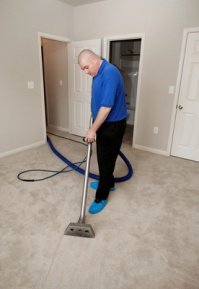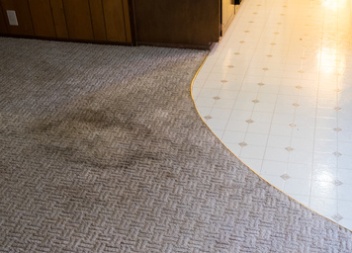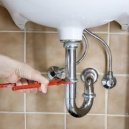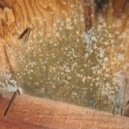Find a pre-screened local mold removal specialist Free Estimate
Find a Mold Specialist Now
Click or Call, Toll-Free 24/7
Carpet Cleaning Mold
People often ask us about carpet cleaning mold ridden carpets and unfortunately, it is usually not possible to clean moldy carpets thoroughly. Not only is it nearly impossible to completely remove mold from carpet, it does not make financial sense. The costs involved in cleaning the mold far outweigh the cost of carpet and pad replacement. The only time saving a carpet that contains or has been exposed to mold makes sense is when the carpet is made of an expensive wool material (think Persian or hand knotted Oriental) or an exotic animal pelt, like zebra, tiger, or bear.
Most of today’s carpet cleaners, if they are smart, will not attempt to clean mold from high end carpet and area rugs. Unless they have had specific training in dealing with these types of exotic carpets, they can ruin them in their attempt to clean them.
Mold in carpets becomes embedded in the carpet fibers and the carpet backing. Most carpet backings are made with latex, and latex is an organic material, thus, a food source for mold. Most carpets are manufactured with a primary backing and at least one secondary backing, and all backings contain some amount of latex.
Why Is Cleaning Moldy Carpets Impossible?
It’s next to impossible to remove mold completely from a number of materials, especially fabrics, including carpets, mattresses, and couch cushions. These materials are porous, meaning they have thousands of microscopic pores, or holes, much like the pores in your skin. While you might be able to remove the mold on the surface, you won’t be able to scrub away the mold inside those pores. Even if the carpet looks clean to the naked eye, microscopic mold spores will remain in the pores. Since most types of mold reproduce rapidly, it won’t be long before your carpet appears moldy again.
What About Professional Carpet Cleaning?
Even getting carpets professionally cleaned won’t remove all traces of mold. The carpets may look clean to the naked eye initially, but at least a few microscopic mold spores will remain in the pores of the carpet fibers. When you have carpets professionally cleaned, they usually remain slightly damp for a day or two. That moisture will provide just what those remaining mold spores need to reproduce and it will probably not be long before you have a mold problem again. If you combine warm temperatures (just about everyone’s house is warm), hot water (the carpet industry’s recommended type of cleaning method - hot water extraction), and an organic food source (the latex contained in the carpet’s backing), you’ve created the prefect environment for mold to grow in.
In addition, having carpets professionally cleaned does not remove mold from any padding beneath the carpets. It also does not remove any mold growing on the floorboards beneath the carpet. When there is mold in carpets, there is often mold below, as well, and that must also be removed. If you are going to have to (at least temporarily) remove the carpet to address the underlying problems, why not just throw out the old carpet and replace it with new? It will be cheaper and safer (no risk of health issues from missed mold spores) in the long run.
There are professionals who specialize in cleaning and caring for exotic area rugs and carpets. And while their services are never inexpensive, if the value of the carpet warrants it, their services are worth looking into. Otherwise we recommend removal and replacement.
Dealing with Mold in Carpets
Since carpet cleaning mold ridden carpets is not effective, what do you do if you have moldy carpet? The carpet must be carefully pulled up, cut into manageable pieces, and sealed in sturdy plastic garbage bags for their safe disposal (to prevent spreading mold spores throughout the house as you carry the moldy carpets out), and then replaced with new, mold-free carpets. If the moldy carpet is in a room that stays damp a lot, like a bathroom or laundry room, consider replacing the carpet with ceramic tile or linoleum instead (linoleum is different from vinyl in that most vinyl floor coverings have a paper backing and linoleum doesn’t). Ceramic tile and linoleum are easier to keep dry than carpet, and it is easier to remove mold if it ever becomes contaminated by mold in the future.
When removing moldy carpet, it’s important to check for mold beneath the carpet, as well. The padding beneath moldy carpet may be moldy and the floorboards themselves may be moldy. Moldy padding must be removed and replaced, just like moldy carpet. Moldy floorboards must be removed and replaced, too, but the entire removal process must be done very carefully in order to prevent the spread of mold spores to other areas of the home and also to prevent exposing you and your family members to mold spores that could make you sick.
When removing moldy floorboards, experts recommend blocking off your work area by setting up containment chambers using large sheets of heavy plastic to seal the affected areas, then setting up negative pressure in the area. Use a vacuum with a HEPA filter while sawing through the moldy floorboards and to remove any sawdust and dirt that may contain mold spores. Here is more on the mold remediation process, including personal protection that should be worn when removing moldy materials. The mold removal process is much more complicated than most people realize.
We suggest consulting with a mold remediation professional before attempting to remove and replace moldy carpets, padding or floorboards. You would also do well to consult with a professional if you have mold covering any large area in your home. If you have mold in your HVAC system, your air ducts, or if you have any respiratory problems such as asthma that might be made worse by exposure to mold during the cleanup process, you should seek professional advice before attempting to remove mold. Most mold remediation professionals offer free in-home consultations, so there’s nothing to lose by making an appointment. Get a list of experienced professionals near you by following the link.
Return From Carpet Cleaning Mold To Our Main Carpet Mold Page
Free Home Inspection By A Mold Removal Specialist
Search This Website
 Steam cleaning carpets will not remove all the mold.
Steam cleaning carpets will not remove all the mold.Recent Articles
-
See Our 5 Recommended Mold Removal Companies in Covington, KY
Apr 16, 25 12:59 PM
-
See Our 5 Recommended Mold Removal Companies in Wheaton, IL
Jun 20, 24 10:33 AM
-
See Our 5 Recommended Mold Removal Companies in Aberdeen, SD
Oct 08, 21 04:05 PM





